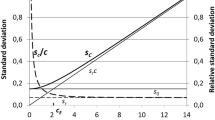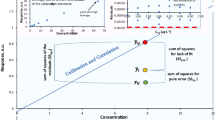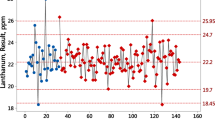Abstract
The papers takes stock of different methods for evaluating the detection (c min) and determination (c lim) limits of components described in the literature and presents a comparative analysis of the results of such evaluations. It is shown that use of the data on the fluctuations of the blank experiment, in spite of their wide application for such evaluations, gives ambiguous estimates for c min and c lim. The most correct method for evaluating the specified parameters is the experimental determination of the actual analyte concentration (content) from the empirical concentration dependence of the relative standard deviation. In case when this estimation method cannot be used, it is recommended to evaluate c lim by the lower boundary of the calibration graph. The article may be useful for inexperienced analysts experimenters in choosing a method for evaluating the results obtained.
Similar content being viewed by others
Rererences
Presentation of the Results of Chemical Analysis: IUPAC Recommendations 1994, Zhurn. anal. khim., 1998, vol. 53, no. 9, p. 999.
Blank, A.B., Analiticheskaya khimiya v issledovanii i proizvodstve neorganicheskikh funktsional’nykh materialov (Analytical Chemistry in the Study and Production of Inorganic Functional Materials), Kharkov: Inst. monokristallov, 2005.
GOST (State Standard) R 52361-2005: Analytical Control: Terms and Definitions, 2005.
CITAC/EURACHEM Guide. Guide to Quality in Analytical Chemistry: an Aid to Accreditation, 2002.
Charykov, A.K., Matematicheskaya obrabotka rezul’tatov khimicheskogo analiza (Mathematical Treatment of the Results of Chemical Analysis), Leningrad: Khimiya, 1984.
Grinzaid, E.L., Zil’bershtein, Kh.I., Nadezhdina, L.S., and Yufa, B.Ya., Zhurn. anal. khim., 1977, vol. 32, no. 11, p. 2106.
Blank, A.B., Zhurn. anal. khim., 1979, vol. 34, no. 1, p. 5.
Zhurn. anal. khim., 1975, vol. 30, no. 10, p. 2058.
Doerffel, K., Statistik in der analytischen Chemie (Statistics in Analytical Chemistry), Leipzig: Grundstoffindustrie, 1990.
Garmash, A.V. and Sorokina, N.M., Metrologicheskie osnovy analiticheskoi khimii (Metrological Bases of Analytical Chemistry), Moscow: Mosk. Gos. Univ., 2005.
Dvorkin, V.I., Metrologiya i obespechenie kachestva kolichestvennogo khimicheskogo analiza (Metrology and Quality Assurance of Chemical Analysis), Moscow: Khimiya, 2001.
GOST (State Standard) R ISO 11843-2-2007: Statistical Methods: Capability of Detection. Part 2: Methodology in The Linear Calibration Case; ISO 11843-3:2000: Capability of Detection. Part 2: Metrology in the Linear Case.
Komar’, N.P., Osnovy kachestvennogo khimicheskogo analiza (Fundamentals of Qualitative Chemical Analysis), Kharkov: Kharkov. Gos. Univ., 1955, vol. 1.
Sharaf, M.A., Illman, D.L., and Kowalski, B.R., Chemometrics, New York: Wiley, 1986.
Pliner, Yu.L., Svechnikova, E.A., and Ogurtsov, V.P., Upravlenie kachestvom khimicheskogo analiza v metallurgii (Quality Management of Chemical Analysis in Metallurgy), Moscow: Metallurgiya, 1979.
Brainina, Kh.Z. and Neiman, E.Ya., Tverdofaznye reaktsii v elektroanaliticheskoi khimii (Solid-State Reactions in Electroanalytical Chemistry), Moscow: Khimiya, 1982.
Nalimov, V.V., Primenenie matematicheskoi statistiki pri analize veshchestva (Application of the Mathematical Statistics in the Analysis of Substances), Moscow: Fizmatgiz, 1960.
Blank, T.A., Eksperiandova, L.P., Sidletskii, O.Ts., et al., Metody ob”ekty khim. analiza, 2007, vol. 2, no. 2, p. 156.
Blank, T.A., Eksperiandova, L.P., and Ostras’, K.S., Zhurn. anal. khim., 2007, vol. 62, no. 2, p. 213 [J. Anal. Chem. (Engl. Transl.), vol. 62, no. 2, p. 193].
Blank, T.A., Eksperiandova, L.P., Sidletsky, O.Ts., et al., Funct. Mater., 2008, vol. 15, no. 2, p. 301.
Montville, D. and Voigtman, E., Talanta, 2003, vol. 59, p. 461.
Mermet, J.-M., Spectrochim. Acta B, 2008, vol. 63, no. 2, p. 166.
Khimchenko, S.V., Eksperiandova, L.P., and Blank, A.B., Khim. tekhnol. vody, 2007, vol. 29, no. 6, p. 506.
Khimchenko, S.V., Eksperiandova, L.P., and Blank, A.B., Zhurn. anal. khim., 2009, vol. 64, no. 1, p. 18 [J. Anal. Chem. (Engl. Transl.), vol. 64, no. 1, p. 14].
Belikov, K.N., Mikhailova, L.I., Shevtsov, N.I., and Blank, A.B., Vestn. Kharkov. Nats. Univ., Ser.: Khim., 2003, no. 10, p. 99.
Eksperiandova, L.P. and Stepanenko, N.A., Analitika i kontrol’, 2008, vol. 12, nos. 3–4, p. 1254.
Blank, A.B., Zhurn. anal. khim., 1965, vol. 20, no. 1, p. 3.
Blank, A.B. and Voronkova, A.Ya., Zavod. Lab., 1965, vol. 31, no. 1, p. 1299.
Blank, T.A. and Eksperiandova, L.P., Abstracts of Papers, II Mezhdunarodnyi forum “Analitika i analitiki” (II Int. Conf. “Analitics and Analyticians”), Voronezh, 2008, vol. 2, p. 700.
Blank, T.A., Eksperiandova, L.P., and Ostras’, K.S., Zhurn. khim. khim. tekhnol., 2006, no. 6, p. 9.
Armbruster, D.A., Tillmann, M.D., and Hubbs, L.M., Clin. Chem., 1994, vol. 40, no. 7, p. 1233.
GOST (State Standard) R ISO 11843-3-2005: Capability of Detection. Part 3: Methodology for Determination of the Critical Value for the Response Variable when no Calibration Data are Used; ISO 11843-3:2003: Capability of Detection. Part 3: Methodology for Determination of the Critical Value for the Response Variable when no Calibration Data are Used.
GOST (State Standard) R ISO 11843-4-2005: Capability of Detection. Part 4: Methodology for Comparing the Minimum Detectable Value with a Given Value; ISO 11843-4:2003: Capability of Detection. Part 4: Methodology for Comparing the Minimum Detectable Value with a Given Value.
Author information
Authors and Affiliations
Additional information
Original Russian Text © L.P. Eksperiandova, K.N. Belikov, S.V. Khimchenko, T.A. Blank, 2010, published in Zhurnal Analiticheskoi Khimii, 2010, Vol. 65, No. 3, pp. 229–234.
Rights and permissions
About this article
Cite this article
Eksperiandova, L.P., Belikov, K.N., Khimchenko, S.V. et al. Once again about determination and detection limits. J Anal Chem 65, 223–228 (2010). https://doi.org/10.1134/S1061934810030020
Received:
Accepted:
Published:
Issue Date:
DOI: https://doi.org/10.1134/S1061934810030020




